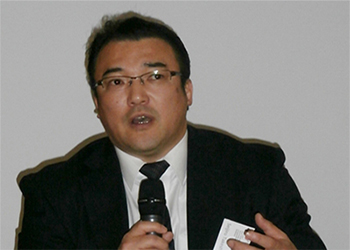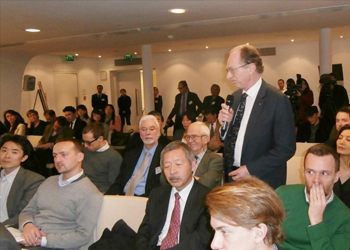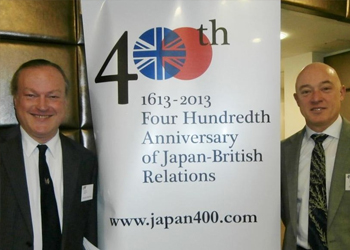King James, the Shogun and Now: Celebrating 400 years of Japan-British Relations, 1613-2013

Japan400 Press Launch
Thursday 10 January 2013
Mandela Room, Commonwealth Club
25 Northumberland Avenue WC2N 5AP
Review by David Watts with photos by Sean Curtin
Saturday 12 January 2013 marked four hundred years since a British ship sailed for Japanese waters to establish the first contact between the two nations and start a mutually-beneficial relationship which prospers to this day. In 1613 the arrival of the The East India Company vessel the Clove helped spark the beginning of Japan’s emergence as a modern nation—knowledge-thirsty Japanese later stowed away on ships returning to glean all Britain had to offer. Today influence is arguably greatest in the opposite direction with no British household or high street bereft of the benefits of Japanese technology and Japanese carmakers based here leading the export charge. Anime, Japanese animation films, and manga cartoons are vibrant art forms that have seeped into our consciousness while work practices and even the notion of removing dirty street shoes at the door we owe to the island nation which is almost our mirror image. “Every British household is influenced by Japan and Japanese culture,” said Professor Timon Screech, head of the School of Arts, School of Oriental and African Studies, University of London, who is the moving spirit behind the year-long celebrations of Japan400 and is writing a book on the period.
It is hard to appreciate the courage of the crewmen of the Clove who sailed into the unknown en route to the land ruled by the Tokugawa Shoguns or military rulers. British people then knew more about the Indies and Africa than they knew about Japan and the welcome awaiting the captain of the Clove, John Saris, and his men was uncertain. In the event they were well received and Tokugawa Ieyasu subsequently gave permission for the English to establish a permanent presence and trade. The shogun’s seal confirming the arrangement can be seen today in the Bodleian Library in Oxford but the valuable Japanese screens gifted to the visitors were highly appreciated by King James and valued at £5 apiece, the equivalent of a Caravaggio, are no longer extant. For their part the visitors handed over the first telescope seen in Asia as a gift, shortly years after its invention in an early example of technology transfer. Goods shipped back to Britain on the Clove were subsequently disposed of in the first art auction in this country on Dec 20 1614. In a letter to King James 1 the shogun wrote: “Send your subjects to any part or port of my dominions. They shall be most welcome. Though separated by ten thousand leagues of clouds and waves, our territories are as it were close to each other.”The East Indiaman and its crew were unwittingly the first instruments in a process that we now recognise as globalisation and The East India Company (EIC), which is today enjoying a new lease of life under Sanjiv Mehta, an Indian of British nationality, established the international trading veins which became the British Empire and the morphed into the Commonwealth. It was the world’s first multi-national company and in Calcutta its tax office eventually assumed that role for the whole of the Empire. But the EIC’s secret was that it was very much a local company from the start. The EIC, the only British company with the right to mint its own coins, is planning a range of exciting new products to mark the 400th anniversary of its arrival in the Land of the Rising Sun, a market which is second only to Britain for its luxury teas and spices for which its staff gave their lives in an earlier age, before we took such things for granted.
The celebrations of this remarkable relationship between east and west begin with the play Anjin: The Shogun and the English Samurai which opens at Sadler’s Wells on January 31 and continue with a year-long flourish of events featuring Japanese art, film and dance, the highlight of which is likely to be the largest exhibition of Japanese art for a decade at the British Museum in the autumn.www.japan400.com
Speakers at the Japan400 Press Launch
- Professor Timon Screech, Co-chair of Japan400; Head of the School of Arts, SOAS
- Nicolas Maclean, Co-chair of Japan400; Pioneer of the Japanese Exchange and Teaching (JET) Programme
- William Horsley, Japan400 Media Group; former BBC Tokyo correspondent
- Seijiro Takeshita, Director, Mizuho International
- Sir David Warren, Chairman of the Japan Society and retiring UK Ambassador in Japan
- Susan Haydock, Chair of Medway Council Japan Group and Honorary Mayor of Yokosuka
- Yuichiro Hanyu, Director of Japan Local Government Centre (CLAIR)
- London Professor Andrew Gerstle, Co-curator of the forthcoming exhibition Shunga: Sex and Humour in Japanese Art, 1600-1900, British Museum
For further information on Japan400 please visit the official website here

Mizuho International

the Japan Society

the speakers during the Q&A.

and Nicolas Maclean

